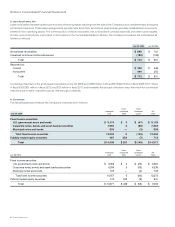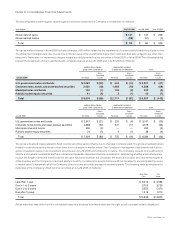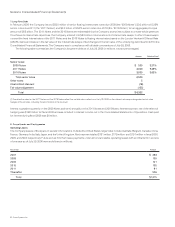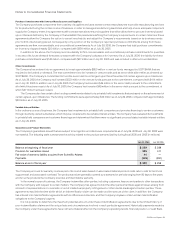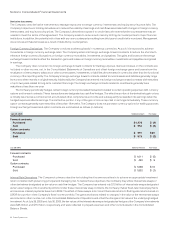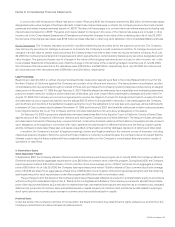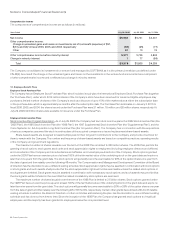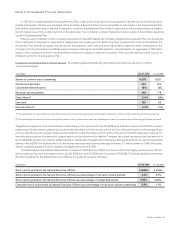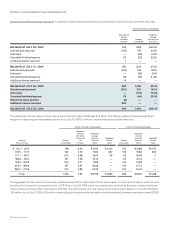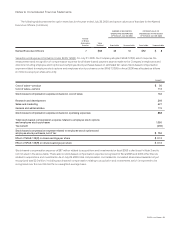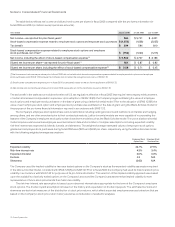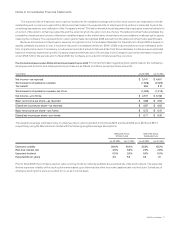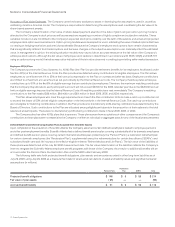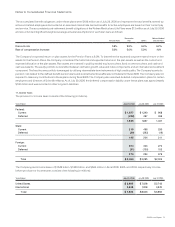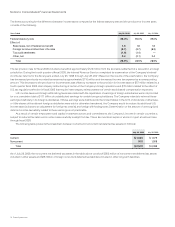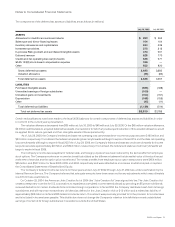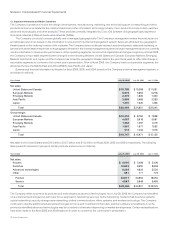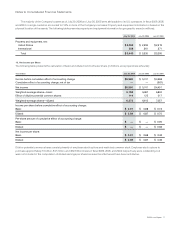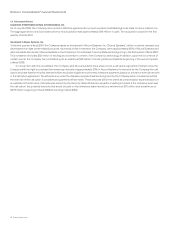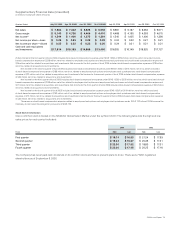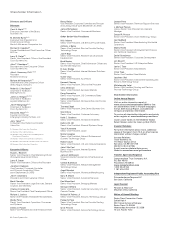Cisco 2006 Annual Report Download - page 67
Download and view the complete annual report
Please find page 67 of the 2006 Cisco annual report below. You can navigate through the pages in the report by either clicking on the pages listed below, or by using the keyword search tool below to find specific information within the annual report.
70 Cisco Systems, Inc.
The table below reects net income and diluted net income per share for scal 2006 compared with the pro forma information for
scal 2005 and 2004 (in millions except per-share amounts):
Years Ended July 29, 2006 July 30, 2005 July 31, 2004
Net income—as reported for prior fiscal years(1) N/A $ 5,741 $ 4,401
Stock-based compensation expense related to employee stock options and employee stock purchases $ (1,050) (1,628) (2,025)
Tax benefit $ 294 594 810
Stock-based compensation expense related to employee stock options and employee
stock purchases, net of tax(2) $ (756) (1,034) (1,215)
Net income, including the effect of stock-based compensation expense(3) $ 5,580 $ 4,707 $ 3,186
Diluted net income per share—as reported for prior fiscal years(1 ) N/A $ 0.87 $ 0.62
Diluted net income per share, including the effect of stock-based compensation expense(3) $ 0.89 $ 0.71 $ 0.45
(1) Net income and net income per share prior to scal 2006 did not include stock-based compensation expense related to employee stock options and employee
stock purchases under SFAS 123 because the Company did not adopt the recognition provisions of SFAS 123.
(2) Stock-based compensation expense prior to scal 2006 is calculated based on the pro forma application of SFAS 123.
(3) Net income and net income per share prior to scal 2006 represents pro forma information based on SFAS 123.
The tax benet in the table above includes the effect of U.S. tax regulations effective in scal 2005 that require intercompany reimbursement
of certain stock-based compensation expenses. Upon adoption of SFAS 123(R), the Company began estimating the value of employee
stock options and employee stock purchases on the date of grant using a lattice-binomial model. Prior to the adoption of SFAS 123(R), the
value of each employee stock option and employee stock purchase was estimated on the date of grant using the Black-Scholes model for
the purpose of the pro forma nancial information required in accordance with SFAS 123.
The Company’s employee stock options have various restrictions including vesting provisions and restrictions on transfer and hedging,
among others, and are often exercised prior to their contractual maturity. Lattice-binomial models are more capable of incorporating the
features of the Company’s employee stock options than closed-form models such as the Black-Scholes model. The use of a lattice-binomial
model requires extensive actual employee exercise behavior data and a number of complex assumptions including expected volatility,
risk-free interest rate, expected dividends, kurtosis, and skewness. The weighted-average estimated values of employee stock options
granted and employee stock purchases during scal 2006 were $5.15 and $4.66 per share, respectively, using the lattice-binomial model
with the following weighted-average assumptions:
Employee Stock
Option Plans
Employee Stock
Purchase Plan
Expected volatility 23.7% 27.5%
Risk-free interest rate 4.3% 3.4%
Expected dividend 0.0% 0.0%
Kurtosis 4.3 N/A
Skewness (0.62) N/A
The Company used the implied volatility for two-year traded options on the Company’s stock as the expected volatility assumption required
in the lattice-binomial model, consistent with SFAS 123(R) and SAB 107. Prior to scal 2006, the Company had used its historical stock price
volatility in accordance with SFAS 123 for purposes of its pro forma information. The selection of the implied volatility approach was based
upon the availability of actively traded options on the Company’s stock and the Company’s assessment that implied volatility is more
representative of future stock price trends than historical volatility.
The risk-free interest rate assumption is based upon observed interest rates appropriate for the term of the Company’s employee
stock options. The dividend yield assumption is based on the history and expectation of dividend payouts. The estimated kurtosis and
skewness are technical measures of the distribution of stock price returns, which affect expected employee exercise behaviors that are
based on the Company’s stock price return history as well as consideration of academic analyses.
Notes to Consolidated Financial Statements


